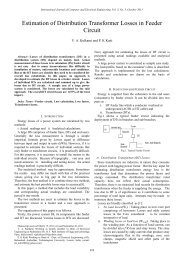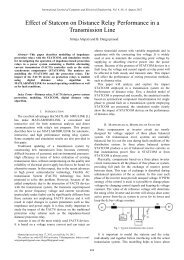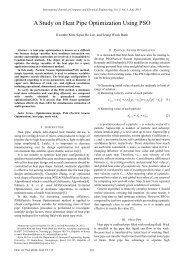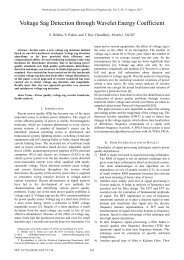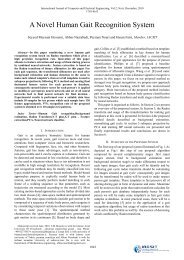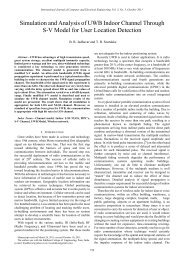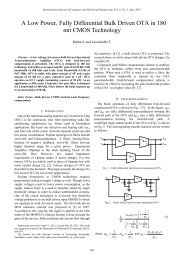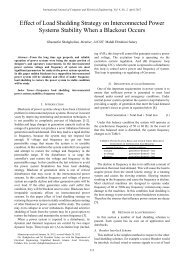Application of Phase Shifting Transformer in Indian Power ... - ijcee
Application of Phase Shifting Transformer in Indian Power ... - ijcee
Application of Phase Shifting Transformer in Indian Power ... - ijcee
You also want an ePaper? Increase the reach of your titles
YUMPU automatically turns print PDFs into web optimized ePapers that Google loves.
International Journal <strong>of</strong> Computer and Electrical Eng<strong>in</strong>eer<strong>in</strong>g, Vol.4, No.2, April 2012<br />
<strong>Application</strong> <strong>of</strong> <strong>Phase</strong> <strong>Shift<strong>in</strong>g</strong> <strong>Transformer</strong> <strong>in</strong> <strong>Indian</strong><br />
<strong>Power</strong> System<br />
Tirupathi Reddy, Aruna Gulati, M. I. Khan, and Ramesh Koul<br />
<br />
Abstract―The country is poised to double the power<br />
generation by 2012. With the result the transmission &<br />
distribution is <strong>in</strong>creas<strong>in</strong>g many fold. The optimal use <strong>of</strong><br />
exist<strong>in</strong>g <strong>in</strong>frastructure needs to be done <strong>in</strong> order to conta<strong>in</strong><br />
<strong>in</strong>vestment. It is therefore necessary to load the exist<strong>in</strong>g l<strong>in</strong>es to<br />
optimal capacity rather than provid<strong>in</strong>g the additional corridor.<br />
Sometimes it is necessary to provide additional corridor <strong>in</strong><br />
order to ma<strong>in</strong>ta<strong>in</strong> system’s reliability and availability. Over<br />
load<strong>in</strong>g <strong>of</strong> subsystem <strong>in</strong> a power system sometimes may pose<br />
stability issues, which may lead to unwanted tripp<strong>in</strong>g,<br />
equipment failures which will result long repair/ replacement<br />
cycle and heavy revenue losses. Under these conditions, to<br />
ensure economical and reliable operation <strong>of</strong> the grid, power<br />
through the l<strong>in</strong>es should be controlled with<strong>in</strong> their capabilities.<br />
In case <strong>of</strong> HVDC systems, the power is automatically<br />
controlled as desired by the operator however, control <strong>of</strong><br />
power <strong>in</strong> AC network requires special technology to be<br />
implemented on case to case basis. Operat<strong>in</strong>g efficiency <strong>of</strong><br />
electric transmission system can be improved by us<strong>in</strong>g<br />
appropriate FACTS devices. <strong>Phase</strong> shift<strong>in</strong>g transformer is one<br />
<strong>of</strong> the FACTS family, which can be used for power control <strong>in</strong> a<br />
network. For demonstrat<strong>in</strong>g the ability <strong>of</strong> the phase shift<strong>in</strong>g<br />
transformer <strong>in</strong> regulat<strong>in</strong>g the power flow <strong>in</strong> an alternate<br />
transmission network, simulation <strong>of</strong> Maharashtra zone and<br />
Utter Pradesh zone <strong>of</strong> an <strong>Indian</strong> grid is considered. From<br />
power flow solution, various overloaded l<strong>in</strong>es and the alternate<br />
under loaded l<strong>in</strong>es are identified. Different cases are simulated<br />
to regulate the power us<strong>in</strong>g phase shift<strong>in</strong>g transformer. By<br />
<strong>in</strong>troduc<strong>in</strong>g phase shift<strong>in</strong>g transformer <strong>in</strong> to the actual network<br />
<strong>of</strong> the <strong>Indian</strong> Grid, power flows <strong>in</strong> the area <strong>of</strong> <strong>in</strong>terest is re<br />
validated and application <strong>of</strong> PST is justified.<br />
Index Terms―<strong>Phase</strong> shift<strong>in</strong>g transformer, power flow<br />
control, over loaded l<strong>in</strong>es, PSS/E<br />
I. INTRODUCTION<br />
<strong>Indian</strong> economy is grow<strong>in</strong>g at a fast pace. GDP is<br />
expected to grow at a rate <strong>of</strong> 8 to 10%. Infrastructure<br />
<strong>in</strong>clud<strong>in</strong>g power is the ma<strong>in</strong> factor for the growth. The<br />
demand for power is <strong>in</strong>creas<strong>in</strong>g steadily.<br />
The estimated peak demand amount<strong>in</strong>g to 110000 MW <strong>in</strong><br />
2006-07 is expected to grow to 1,50,300 MW <strong>in</strong> 2011-12.<br />
Thus, the <strong>in</strong>stalled capacity <strong>of</strong> 1,39,372 MW <strong>in</strong> 2006-07 is<br />
planned to be 2,03,529 MW by 2011.-12.<br />
To meet this target, Government has decided to develop<br />
large capacity power projects at national level. Already<br />
seven Ultra Mega <strong>Power</strong> Projects (UMPP) <strong>of</strong> 4000 MW<br />
each have been identified. These are planned at pit head and<br />
coastal sites. Three pit head sites are Sasan <strong>in</strong> M. P.,<br />
Akaltara <strong>in</strong> Chattisgarh and a site to be decided <strong>in</strong> Orissa.<br />
Manuscript received January 20, 2012; revised April 1, 2012. This work<br />
was supported <strong>in</strong> part by Bharat Heavy Electricals Limited.<br />
The authors are with Bharat Heavy Electrical Limited, New Delhi, India<br />
(e-mail: ttreddy@bhel<strong>in</strong>dustry.com, aruna@bhel<strong>in</strong>dustry.com,<br />
mikhan@bhel<strong>in</strong>dustry.com, rkoul@bhel<strong>in</strong>dustry.com).<br />
Four coastal sites are <strong>in</strong> Andhra Pradesh, Gujarat,<br />
Maharashtra and Karnataka [1].<br />
Transmission grid is used as a transport medium between<br />
generation and load centers. Transmission plann<strong>in</strong>g has to<br />
be done <strong>in</strong> such a way that besides conserv<strong>in</strong>g Right <strong>of</strong> Way<br />
(ROW) for new l<strong>in</strong>es, optimum utilization <strong>of</strong> exist<strong>in</strong>g l<strong>in</strong>es<br />
has to be made.<br />
Physical path between generation and load centers for<br />
power transmission is a group <strong>of</strong> alternate paths.<br />
There could be uneven load<strong>in</strong>g <strong>of</strong> parallel transmission<br />
l<strong>in</strong>es due to different impedances caused by the tower<br />
geometry, conductor siz<strong>in</strong>g, number <strong>of</strong> sub-conductors and<br />
l<strong>in</strong>e length. The distribution <strong>of</strong> the power flow between two<br />
parallel l<strong>in</strong>es is dictated by their impedances. The l<strong>in</strong>e with<br />
the smaller impedance carries more power and vice versa.<br />
In most situations, one <strong>of</strong> the two l<strong>in</strong>es will be operat<strong>in</strong>g<br />
well below its nom<strong>in</strong>al rat<strong>in</strong>g because otherwise parallel l<strong>in</strong>e<br />
with lower impedance would be overloaded [2].<br />
Due to uneven load<strong>in</strong>g <strong>of</strong> <strong>in</strong>terconnectors <strong>in</strong> meshed<br />
networks, the total power transmission from generation to<br />
load center, is lower than expected when look<strong>in</strong>g at the<br />
capacities <strong>of</strong> the l<strong>in</strong>es.<br />
In view <strong>of</strong> above, the power flows need to control <strong>in</strong> order<br />
to achieve the optimum utilization <strong>of</strong> transmission l<strong>in</strong>es<br />
capacity. A phase shift<strong>in</strong>g transformer (PST) can be<br />
employed for power control <strong>in</strong> transmission l<strong>in</strong>es.<br />
<strong>Transformer</strong>s are used to transport electrical power<br />
between different voltage levels <strong>of</strong> the electric grid. Special<br />
transformers used to create a phase shift between the<br />
primary side voltage and secondary side voltage, are termed<br />
phase shift<strong>in</strong>g transformers. The purpose <strong>of</strong> this phase shift<br />
is to control the power flow over transmission l<strong>in</strong>es. Both<br />
the magnitude and direction <strong>of</strong> power flow can be controlled<br />
by vary<strong>in</strong>g the phase shift [3].<br />
II. PHASE SHIFTING TRANSFORMER<br />
The active power and reactive power transmission over a<br />
transmission l<strong>in</strong>e is given by the follow<strong>in</strong>g equations:<br />
Vs Vr<br />
P s<strong>in</strong><br />
XL<br />
(1)<br />
Vs Vr Vr <br />
Q cos (2)<br />
XL <br />
<br />
Vs <br />
where Vs, Vr are send<strong>in</strong>g end and receiv<strong>in</strong>g end voltages<br />
respectively. δ is power angle, XL is l<strong>in</strong>e reactance.<br />
The active power is proportional to the voltages on the<br />
send<strong>in</strong>g and receiv<strong>in</strong>g side and to the s<strong>in</strong>e <strong>of</strong> the electrical<br />
242
International Journal <strong>of</strong> Computer and Electrical Eng<strong>in</strong>eer<strong>in</strong>g, Vol.4, No.2, April 2012<br />
angle between both sides; it is also <strong>in</strong>versely proportional to<br />
the l<strong>in</strong>e reactance. Alter<strong>in</strong>g the active power can be done by<br />
alter<strong>in</strong>g the voltages, but this has a bigger <strong>in</strong>fluence on the<br />
reactive power, so this method is not very effective.<br />
Fig. 1. Model <strong>of</strong> transmission l<strong>in</strong>e without and with a PST [2]<br />
The method discussed is the method <strong>of</strong> alter<strong>in</strong>g the<br />
electrical angle, as shown <strong>in</strong> Fig. 1. The PST is modeled as<br />
a reactance (X PST ) <strong>in</strong> series with a phase shift. The power<br />
flow through the l<strong>in</strong>e is <strong>in</strong>creased by add<strong>in</strong>g an angle α to<br />
the exist<strong>in</strong>g angle δ. The phase shift is controllable with<strong>in</strong><br />
certa<strong>in</strong> limits [2]. Equation (1) becomes:<br />
Vs Vr<br />
P s<strong>in</strong> <br />
(3)<br />
XL <br />
X PST<br />
Fig. 2 shows connection diagram <strong>of</strong> conventional phase<br />
shift<strong>in</strong>g transformer. It consists <strong>of</strong> an excitation transformer<br />
(ET), a boost<strong>in</strong>g transformer (BT), and set <strong>of</strong> mechanical<br />
switches. Basic function <strong>of</strong> PST is to control power flow<br />
through the transmission l<strong>in</strong>e. This is accomplished by<br />
modify<strong>in</strong>g the voltage phase angle by <strong>in</strong>sert<strong>in</strong>g a variable<br />
voltage (VB) <strong>in</strong> series with transmission l<strong>in</strong>e. This voltage<br />
is provided by the excitation transformer, amplitude is<br />
controlled by tap changer. The leakage reactance (XPST) <strong>of</strong><br />
boost<strong>in</strong>g transformer is <strong>in</strong> series with the l<strong>in</strong>e impedance [4].<br />
III. MAIN CATEGORIES OF PSTS<br />
For <strong>in</strong>fluenc<strong>in</strong>g the real power flow, the most <strong>of</strong>ten used<br />
are the quadrature symmetric or the quadrature nonsymmetric<br />
PST’s.<br />
A quadrature type phase shifter is a unit where the boost<br />
voltage, which creates the phase shift between source and<br />
load term<strong>in</strong>als, is perpendicular to the l<strong>in</strong>e voltage at one<br />
term<strong>in</strong>al, or to a comb<strong>in</strong>ation <strong>of</strong> the l<strong>in</strong>e voltages at source<br />
and load term<strong>in</strong>als.<br />
The term “symmetric” means, that under no load<br />
condition the voltage magnitude at load side is always equal<br />
to the voltage magnitude at the source side, <strong>in</strong>dependent<br />
from the phase angle.<br />
Quadrature non-symmetric devices add a quadrature<br />
voltage to the <strong>in</strong>put voltage. The output voltage is the<br />
vector sum <strong>of</strong> these two perpendicular voltages (therefore<br />
the output voltage is boosted by a small amount).<br />
Voltage phasor diagrams for different transformers are<br />
shown <strong>in</strong> the Fig. 3. The voltage control by classical<br />
regulat<strong>in</strong>g transformer is shown <strong>in</strong> Fig. 3a, the phase angle<br />
control by quadrature symmetric PST is shown <strong>in</strong> Fig. 3b<br />
and Fig. 3c shows the phase angle control by quadrature<br />
non-symmetric PST [6].<br />
IV. PST MODEL IN PSS/E SOFTWARE<br />
PSS/E s<strong>of</strong>tware is used for model<strong>in</strong>g the system. The<br />
equivalent circuit <strong>of</strong> Fig. 4 used to represent adjustable<br />
phase shifters. These units use tapped zigzag-connected<br />
w<strong>in</strong>d<strong>in</strong>gs to produce an adjustable phase shift between<br />
primary and secondary w<strong>in</strong>d<strong>in</strong>gs.<br />
PSS/E allows the user to specify both the amplitude<br />
w<strong>in</strong>d<strong>in</strong>g ratios and phase shift <strong>of</strong> transformer. The phase<br />
shift angle is the angle by which w<strong>in</strong>d<strong>in</strong>g 1 leads w<strong>in</strong>d<strong>in</strong>g 2.<br />
PSS/E power flow solution <strong>in</strong>cludes logic for automatic<br />
adjustment <strong>of</strong> both turns ratio (t) and phase shift. It must be<br />
noted that the automatic adjustment <strong>of</strong> turns ratio does not<br />
alter phase shift and, more importantly, that PSS/E assumes<br />
that turns ratio is <strong>in</strong>dependent <strong>of</strong> adjustment <strong>of</strong> phase shift.<br />
<strong>Power</strong> distribution over the l<strong>in</strong>es depends on the voltage<br />
shift between the voltage at transformer term<strong>in</strong>als as well as<br />
on the impedances [7].<br />
V. SIMULATION AND RESULTS<br />
Bulk power generation and heavy loads are situated far<br />
away from each other. Exist<strong>in</strong>g transmission l<strong>in</strong>es get<br />
overloaded with the new generation plann<strong>in</strong>g; especially<br />
l<strong>in</strong>es with lower impedance will get over load. In order to<br />
ma<strong>in</strong>ta<strong>in</strong> reliability, new transmission l<strong>in</strong>es need to be<br />
erected, which requires additional expenditure.<br />
Alternatively, the exist<strong>in</strong>g <strong>in</strong>frastructure could be used with<br />
optimization us<strong>in</strong>g FACTS devices [8]. The device should<br />
be placed either <strong>in</strong> lightly loaded l<strong>in</strong>e or <strong>in</strong> over loaded l<strong>in</strong>es<br />
to optimize load<strong>in</strong>g conditions. Many other aspects such as<br />
space availability need to be considered.<br />
With the addition <strong>of</strong> generation and transmission system<br />
some times, more than one bus need to be created. It has<br />
been observed that <strong>in</strong> a multi bus configuration <strong>of</strong> substation<br />
sometimes some buses may not be able to support the<br />
load/generation, e. g. at Kottagudem Thermal <strong>Power</strong> Station,<br />
Vizag, 400 kV bus is connected to 220 kV bus through a<br />
conventional ICT. Some <strong>of</strong> the 220 kV l<strong>in</strong>es which are<br />
already over loaded could further over load. Under such<br />
conditions PST between 400 kV Land 220 kV buses not<br />
only load the 400 kV l<strong>in</strong>es to the possible extent but also<br />
relieve the over loaded 220 kV l<strong>in</strong>es to its nom<strong>in</strong>al<br />
capabilities.<br />
Fig. 2. Connection diagram <strong>of</strong> phase shift<strong>in</strong>g transformer [5]<br />
Fig. 3. Voltage phasor diagrams for different transformers [6]<br />
243
International Journal <strong>of</strong> Computer and Electrical Eng<strong>in</strong>eer<strong>in</strong>g, Vol.4, No.2, April 2012<br />
Fig. 4. <strong>Transformer</strong> equivalent circuit represent<strong>in</strong>g phase shift [7]<br />
The aim <strong>of</strong> this paper is to study various applications <strong>of</strong><br />
PST <strong>in</strong> power flow control. The system data for load flow<br />
studies consists <strong>of</strong> the data perta<strong>in</strong><strong>in</strong>g to transmission l<strong>in</strong>es,<br />
generat<strong>in</strong>g transformers, <strong>in</strong>terconnect<strong>in</strong>g transformers,<br />
HVDC converters, generation, substation-wise load<br />
distribution, shunt compensation and series compensation<br />
etc. M/s <strong>Power</strong> Grid Corporation <strong>of</strong> India Limited (PGCIL)<br />
has provided the network steady state data <strong>of</strong> 2012 for peak<br />
load. The data are also verified by M/s Central Electricity<br />
Authority (CEA).<br />
Various cases <strong>in</strong> Maharashtra zone and Utter Pradesh<br />
zone <strong>of</strong> <strong>Indian</strong> grid have been studied, to demonstrate the<br />
PST application <strong>in</strong> order to optimize the utilization <strong>of</strong> the<br />
exist<strong>in</strong>g <strong>in</strong>frastructure without over load<strong>in</strong>g.<br />
We used PSS/E s<strong>of</strong>tware for simulation and prepared<br />
SLDs <strong>of</strong> <strong>in</strong>terest <strong>of</strong> area as discussed and shown <strong>in</strong> further<br />
sections.<br />
A. Maharashtra Zone<br />
1) SLPR22 Region<br />
There is a 332 MW load connected at OSMNBD bus,<br />
which is supply<strong>in</strong>g by two l<strong>in</strong>es, 1) from PARL22 to<br />
OSMNBD 2) from SLPR22 to OSMNBD. But, l<strong>in</strong>e<br />
between PARL22 & OSMNBD loaded to 280 MW (full<br />
load consideration is 200 MW) and l<strong>in</strong>e between SLPR22 &<br />
OSMNBD is loaded to 65.3 MW only as shown <strong>in</strong> Fig. 5.<br />
We could make use <strong>of</strong> l<strong>in</strong>e between SLPR22 &<br />
OSMNBD to relieve the overloaded l<strong>in</strong>e between PARL22<br />
& OSMNBD. A PST is <strong>in</strong>troduced <strong>in</strong> l<strong>in</strong>e between SLPR22<br />
& OSMNBD at SLPR22 bus and <strong>in</strong>creased power <strong>in</strong> this<br />
l<strong>in</strong>e to 150 MW <strong>in</strong> the same direction. The l<strong>in</strong>e between<br />
PARL22 & OSMNBD got relieved from over load as shown<br />
<strong>in</strong> Fig. 6.<br />
further buses.<br />
2) KOYAN Region<br />
LPRSRM bus is supply<strong>in</strong>g 187.2 MW load. The power is<br />
loaded from KOYNA2 through 220 kV l<strong>in</strong>e which is loaded<br />
to 268.9 MW. Balance power <strong>of</strong> 81.7 MW is flow<strong>in</strong>g from<br />
LPRSRM to KNDLG2 as shown <strong>in</strong> Fig. 7. The capability <strong>of</strong><br />
l<strong>in</strong>e between KOYNA2 to LPRSRM is only 200 MVA,<br />
which means, it is loaded to 145 %. In order to relieve this<br />
l<strong>in</strong>e from over load<strong>in</strong>g, PST is proposed at LPRSRM bus, <strong>in</strong><br />
l<strong>in</strong>e between LPRSRM and KNDLG2, which can load the<br />
l<strong>in</strong>e between LPRSRM and KNDLG2 l<strong>in</strong>e to 81.6 MW <strong>in</strong><br />
reverse direction, there by reliev<strong>in</strong>g the l<strong>in</strong>e between<br />
KOYNA2 and LPRSRM to its capability as shown <strong>in</strong> Fig. 8.<br />
Also it is ensur<strong>in</strong>g that no other l<strong>in</strong>es <strong>in</strong> the vic<strong>in</strong>ity are<br />
gett<strong>in</strong>g overloaded.<br />
Fig. 6. Network connected to SLPR22 bus with PST<br />
Fig. 7. Network connected to LPRSRM bus without PST<br />
B. Utter Pradesh Zone<br />
We simulated Utter Pradesh zone <strong>of</strong> <strong>Indian</strong> power system,<br />
identified an over loaded 400 kV l<strong>in</strong>e from UNNAO4 to<br />
PANKI4 as shown <strong>in</strong> Fig. 9.<br />
Fig. 5. Network connected to SLPR22 bus without PST<br />
The very purpose <strong>of</strong> PST is to change the power angle <strong>of</strong><br />
bus where it is connected. It can be observed that power<br />
angle can be controlled at specific location which will also<br />
have an effect <strong>in</strong> the entire network around PST.<br />
The effect will be maximum at the bus <strong>in</strong> question and<br />
will be comparatively less on further buses. Hence, there<br />
will be <strong>in</strong>cremental change <strong>in</strong> power flow scenario around<br />
Fig. 8. Network connected to LPRSRM bus with PST<br />
244
International Journal <strong>of</strong> Computer and Electrical Eng<strong>in</strong>eer<strong>in</strong>g, Vol.4, No.2, April 2012<br />
There are alternate l<strong>in</strong>es, which are under loaded. If we<br />
limit the power flow <strong>in</strong> l<strong>in</strong>e between UNNAO4 & PANKI4<br />
to ≤ 500 MW, it will get relieve from over load. Part <strong>of</strong> the<br />
power is diverted through alternate l<strong>in</strong>es.<br />
PST is considered <strong>in</strong> l<strong>in</strong>e between UNNAO4 & PANKI4<br />
at UNNAO4. PST decreased the power <strong>in</strong> l<strong>in</strong>e between<br />
UNNAO4 & PANKI4 from 663.8 MW to 450 MW as<br />
shown <strong>in</strong> Fig. 10.<br />
permitt<strong>in</strong>g publication <strong>of</strong> the paper. Authors are also<br />
thankful to M/s PGCIL and M/s CEA for provid<strong>in</strong>g network<br />
data for enabl<strong>in</strong>g the studies.<br />
REFERENCES<br />
[1] A. K. Asthana, “Transmission Grid – 2022 Perspective,” Grid Tech<br />
New Delhi, India, 2007.<br />
[2] J. Verboomen, D. V. Herten, W. L. Kl<strong>in</strong>g, and R. Belmans, “<strong>Phase</strong><br />
shift<strong>in</strong>g transformers: Pr<strong>in</strong>ciples and applications,” Future <strong>Power</strong><br />
System, International Conference on, 2005.<br />
[3] ABB Review: FACTS – solution to power flow control & stability<br />
problems. Sweden: ABB <strong>Power</strong> System AB, 1999.<br />
[4] S. A. N. Niaki, “A Novel Steady-state Model and Pr<strong>in</strong>ciple <strong>of</strong><br />
Operation <strong>of</strong> <strong>Phase</strong> <strong>Shift<strong>in</strong>g</strong> <strong>Transformer</strong> Compareable with FACTS<br />
New Devices,” IEEE Transaction on power system technology, pp.<br />
1450 -1457, vol. 3.<br />
[5] R. K. Tiwari, J. S. Kuntia, and S. Sachdeva, “Development <strong>of</strong> <strong>Phase</strong><br />
<strong>Shift<strong>in</strong>g</strong> <strong>Transformer</strong>s” Presented <strong>in</strong> International Conference on<br />
transformers-2009 held by CBIP <strong>in</strong> New Delhi, India.<br />
[6] W. Seitl<strong>in</strong>ger , “<strong>Phase</strong> <strong>Shift<strong>in</strong>g</strong> <strong>Transformer</strong>s Discussion <strong>of</strong> Specific<br />
Characteristic,” Paris: CIGRE, 1998.<br />
[7] PSSE 32 User Manual, “Program <strong>Application</strong> Guide: Volume 1”<br />
[8] W. L. Kl<strong>in</strong>g et al, “<strong>Phase</strong> shift<strong>in</strong>g transformers <strong>in</strong>stalled <strong>in</strong> the<br />
Netherlands <strong>in</strong> order to <strong>in</strong>crease available <strong>in</strong>ternational transmission<br />
capacity,” <strong>in</strong> CIGRE Session 2004 – C2-207, 2004.<br />
Fig. 9. Network around UNNA04 bus without PST<br />
Fig. 10. Network around UNNA04 bus with PST<br />
VI. CONCLUSIONS<br />
The paper has discussed the accelerated growth <strong>of</strong> <strong>Indian</strong><br />
power sector and the need for <strong>in</strong>stall<strong>in</strong>g the PST <strong>in</strong><br />
transmission network. There could be such situations <strong>in</strong><br />
entire <strong>Indian</strong> grid where application <strong>of</strong> PST for control <strong>of</strong><br />
the power could be studied. The paper discussed the basic<br />
pr<strong>in</strong>ciple <strong>of</strong> PST and types <strong>of</strong> PSTs. From simulation<br />
results, it is clear that PST can be used for control <strong>of</strong> active<br />
power distribution over the transmission l<strong>in</strong>es. In case A.1,<br />
we proposed PST <strong>in</strong> under loaded l<strong>in</strong>e for shar<strong>in</strong>g load from<br />
over loaded l<strong>in</strong>e. In case A.2, PST used to change the<br />
direction <strong>of</strong> the power flow <strong>in</strong> alternate under loaded l<strong>in</strong>e.<br />
In case B, PST is <strong>in</strong>troduced <strong>in</strong> overloaded l<strong>in</strong>e itself, to<br />
limit power flow with<strong>in</strong> its capability <strong>in</strong> the same direction.<br />
The paper has reviewed different applications <strong>of</strong> PST for<br />
power control like reliev<strong>in</strong>g over loaded l<strong>in</strong>es.<br />
ACKNOWLEDGMENT<br />
The authors are thankful to M/s BHEL Management for<br />
T. Tirupati Reddy was born <strong>in</strong> Mahabobnagar,<br />
India on 13 th Nov. 1981. He did B.E degree <strong>in</strong><br />
Osmania University, Hyderabad from 2002 to 2006<br />
and M-Tech at IIT Bombay from 2006 to 2008. He<br />
jo<strong>in</strong>ed <strong>in</strong> BHEL, New Delhi on 24 th July 2008, was<br />
assigned work <strong>in</strong> system studies and HVDC group,<br />
where presently he is an Eng<strong>in</strong>eer. His ma<strong>in</strong><br />
work<strong>in</strong>g areas <strong>in</strong>clude Insulation co-ord<strong>in</strong>ation, load<br />
flow, short circuit and HVDC dynamic stability.<br />
hoto<br />
Aruna Gulati was born <strong>in</strong> Machilipatnam, India on<br />
1 st June 1968. She received B. Tech degree <strong>in</strong><br />
Electrical and Electronics Eng<strong>in</strong>eer<strong>in</strong>g and M- Tech<br />
degree from IIT Kanpur <strong>in</strong> control system. She has<br />
jo<strong>in</strong>ed BHEL <strong>in</strong> 1991 as eng<strong>in</strong>eer tra<strong>in</strong>ee. She is<br />
work<strong>in</strong>g <strong>in</strong> BHEL as Deputy GM head<strong>in</strong>g system<br />
studies and HVDC group and eng<strong>in</strong>eer<strong>in</strong>g<br />
coord<strong>in</strong>ator for ±800 kV 6000 MW Multi term<strong>in</strong>al<br />
HVDC NER/ER-NR/WR <strong>in</strong>terconnector –I project. Her ma<strong>in</strong> work<strong>in</strong>g<br />
areas are power system stability and control and Insulation co-ord<strong>in</strong>ation.<br />
M. I. Khan was born on 15th July 1948 <strong>in</strong> Uttar Pradesh, India. He did B.<br />
Tech. degree <strong>in</strong> Electrical and Electronics Eng<strong>in</strong>eer<strong>in</strong>g. He has <strong>in</strong>volved <strong>in</strong><br />
design, eng<strong>in</strong>eer<strong>in</strong>g and commission<strong>in</strong>g <strong>of</strong> national HVDC project, Rihand<br />
– Dadri HVDC and Chandrapur – Padghe HVDC projects. He was retired<br />
as GM <strong>in</strong> BHEL <strong>in</strong> 2008 and work<strong>in</strong>g with BHEL as senior specialist s<strong>in</strong>ce<br />
2008.<br />
Ramesh koul was born on 13th Oct. 1955. He has<br />
graduated (B.E., Electrical) from Punjab Eng<strong>in</strong>eer<strong>in</strong>g<br />
College <strong>in</strong> 1977. He has jo<strong>in</strong>ed BHEL <strong>in</strong> 1977 as<br />
eng<strong>in</strong>eer tra<strong>in</strong>ee. From 1977 to 1985, he was actively<br />
<strong>in</strong>volved <strong>in</strong> project eng<strong>in</strong>eer<strong>in</strong>g and commission<strong>in</strong>g <strong>of</strong><br />
<strong>in</strong>dustrial systems. From 1985 to 1992, he was<br />
<strong>in</strong>volved <strong>in</strong> design eng<strong>in</strong>eer<strong>in</strong>g, system studies and<br />
commission<strong>in</strong>g for National HVDC and Rihand-<br />
Dadri HVDC projects. From 1992 to 2002, he was<br />
head<strong>in</strong>g the eng<strong>in</strong>eer<strong>in</strong>g team <strong>of</strong> Chandrapur-Padghe HVDC Project and<br />
responsible for design eng<strong>in</strong>eer<strong>in</strong>g, system studies and commission<strong>in</strong>g <strong>of</strong><br />
Chandrapur Padghe HVDC project. Ramesh koul was head<strong>in</strong>g the<br />
market<strong>in</strong>g group for transmission and distribution systems from 2003-2006.<br />
From 2006 to 2009, as AGM, HVDC-E, he was head<strong>in</strong>g the HVDC group<br />
look<strong>in</strong>g after various functions such as design, eng<strong>in</strong>eer<strong>in</strong>g, project<br />
eng<strong>in</strong>eer<strong>in</strong>g <strong>of</strong> Ballia Bhiwadi HVDC and EHV projects like Barh. At<br />
present Ramesh koul is head<strong>in</strong>g the eng<strong>in</strong>eer<strong>in</strong>g and quality functions <strong>of</strong><br />
transmission bus<strong>in</strong>ess group as General Manager (engg. and quality)<br />
look<strong>in</strong>g after eng<strong>in</strong>eer<strong>in</strong>g and quality functions <strong>of</strong> both HVDC and<br />
substation projects <strong>in</strong>clud<strong>in</strong>g the prestigious ±800 kV, 6000MW North East<br />
Agra HVDC project (first <strong>of</strong> its k<strong>in</strong>d <strong>in</strong> the world).<br />
245



